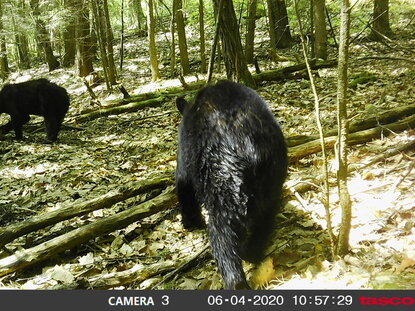 Bears captured on game camera in the forests of Painted Post. Bears captured on game camera in the forests of Painted Post. “I want to see a bear!” (4-minute read) I stared at the text message on my cell phone. It was from a good friend, and while she meant well—and would never intentionally harm any animal—my immediate thoughts were: “No. No you don’t want to see a bear. Up close anyway.” To be fair, since that message a few year ago, she has come to hold a healthy respect for what the American Black Bear, Ursus Americanus, can do. On nearly a dozen occasions, I’ve come across black bears in the woods of Painted Post. This does not include the many more times I have seen them from my truck. Ironically, two of these closest bear encounters, I was only armed for squirrel. (Story of my life, but I digress.) And every time I let the bear know I was there. The smaller of the two bears—weighing about 150 pounds I’d guess—was only 25 feet away and on a collision course with me when I said in a normal voice, “That’s close enough, fella.” Once the bear realized I wasn’t part of the white pine tree I leaned against, it quickly wheeled and departed the area. I let the bear know I was there because I understood a bear’s visual acuity is only about as good (some say a little worse) than humans. Had it come closer, and been surprised, I might not be writing this blog entry. The next season, the second bear I had a close encounter with popped over the edge of a steep ravine. This one was larger—at least 250 pounds. This one saw me immediately and froze. I said very calmly, “Move along.” Thank goodness, it did, although it departed at a much more leisurely pace than the first bear. Some Good Advice
You must understand this: An adult American Black Bear can outrun you, can climb any tree you can (and many you can't) much faster, and its strength will quickly overpower you. So what do you do? The first is to be prepared for such an encounter with some prior education. Here’s some good advice on what to do with a bear encounter from the U.S. National Park Service (NPS). (And you’ll see as you read the NPS's recommendation—my responses to the mentioned encounters and positive results follows their guidelines.) And some (bad) examples Most have heard that you should never get between a mother bear and her cub. This truism has been repeated so much it’s become a cliché and over-used metaphor for human parents and their children. (For the record, I support both bear and humans protecting their own.) And let me add quickly, don’t even come near a mother bear with cubs. If she thinks you’re a threat even at a hundred yards, there is the possibility she decides to attack. But there’s always those select few . . . humans. Both these articles are courtesy of Wide Open Spaces and show man vs. mother-bear-with-cubs meetings. (Note: thankfully, both of these encounters work out well in the end, but both are likewise quite dicey.) This first gentleman I have some sympathy for, although the article's author isn’t as forgiving. In the video attached with this article, the hiker is being backed up by a very large female bear (this isn’t a black bear from what I can tell, but the point is the same). The article suggests he probably should have stepped off the trail and let the bears pass by. I tend to agree with that call. Remember: you’re never going to outrun a bear over even a moderate distance—so while stepping off into the woods might slow your ability to run—the point is moot if the bear is going to attack anyway. This second gentlemen is simply downright ignorant (assuming he's sober) of what a mother bear could do. This encounter shown via video doesn’t turn into a tragedy, but that's only because fate intervened favorably on behalf of the man. The bottom line is this; When it comes to man-bear relations, it comes down to a matter of respect, which means avoiding encounters if you can at all help it and remaining calm and following the NPS's advice if you do come into close range of the American black bear.
0 Comments
Your comment will be posted after it is approved.
Leave a Reply. |
Categories
All
|
- Ryland Creek
- About The Ryland Creek Novels
- Buy the Ryland Creek Saga: Print Books
- Buy the Ryland Creek Saga in E-Book
- The Ryland Creek Saga in Audiobook
- Blog: In a place called Painted Post
- Reader Reviews for The Ryland Creek series
- Meet the Author:Joseph Gary Crance
- An Ode to Painted Post
- The Magical Realism of the Ryland Creek Saga
- Other local authors
- Contact
- Leave A Reader Review
- Ryland Creek
- About The Ryland Creek Novels
- Buy the Ryland Creek Saga: Print Books
- Buy the Ryland Creek Saga in E-Book
- The Ryland Creek Saga in Audiobook
- Blog: In a place called Painted Post
- Reader Reviews for The Ryland Creek series
- Meet the Author:Joseph Gary Crance
- An Ode to Painted Post
- The Magical Realism of the Ryland Creek Saga
- Other local authors
- Contact
- Leave A Reader Review

 RSS Feed
RSS Feed